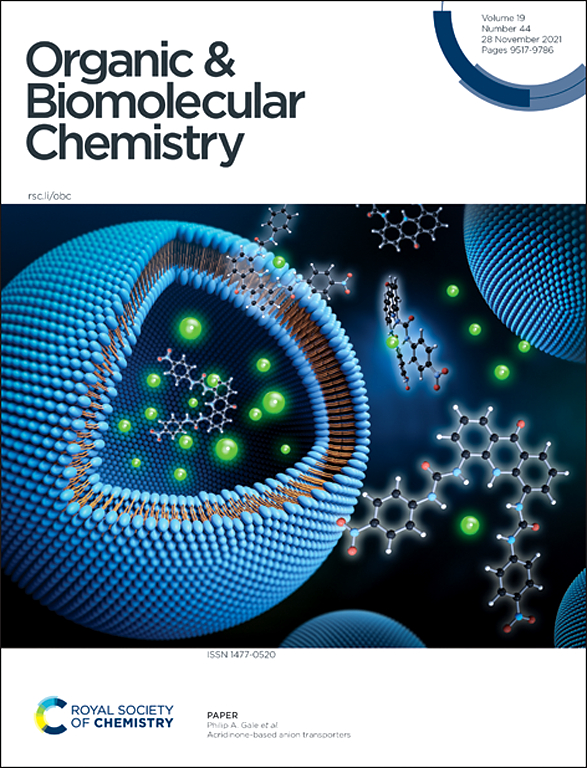反应型荧光探针在食品中甲醛选择性检测及其在活细胞中的成像应用。
IF 2.7
3区 化学
Q1 CHEMISTRY, ORGANIC
引用次数: 0
摘要
甲醛是一种危害环境和人类健康的有毒污染物。迫切需要有效的方法来检测真实样品和生物系统中的FA。在此,我们报告了合理的设计和合成NAPh-Lyso,一种新的基于溶酶体靶向反应的荧光探针,用于快速和选择性地检测FA。NAPh-Lyso整合了三种功能成分,即1,8-萘酰亚胺荧光基团作为信号单元,肼基团作为特异性fa反应位点,以及用于亚细胞定位的morpholine部分。NAPh-Lyso通过独特的希夫碱形成耦合光诱导电子转移(PET)调制机制工作,在水介质中对FA表现出显着的“开启”荧光响应,具有卓越的选择性,快速的响应动力学(本文章由计算机程序翻译,如有差异,请以英文原文为准。
A reaction-based fluorescence probe for selective detection of formaldehyde in food samples and its imaging application in living cells†
Formaldehyde (FA) is a toxic pollutant that threatens both environmental and human health. Effective methods to detect FA in real-world samples and biological systems are urgently needed. Herein, we report the rational design and synthesis of NAPh-Lyso, a new lysosome-targetable reaction-based fluorescent probe for rapid and selective FA detection. NAPh-Lyso integrates three functional components, namely, a 1,8-naphthalimide fluorophore as the signaling unit, a hydrazine group as the specific FA-reactive site, and a morpholine moiety for subcellular localization. NAPh-Lyso operates through a distinctive Schiff base formation-coupled photoinduced electron transfer (PET) modulation mechanism, exhibiting a remarkable “turn-on” fluorescence response to FA in aqueous media with exceptional selectivity, rapid response kinetics (<2 min), and high sensitivity (LOD = 0.21 μM). It enables precise FA quantification in food (cabbage and mushrooms) and water samples (pond water and tap water), and lysosomal FA imaging in live cells. This work presents an advanced analytical platform for FA monitoring, while simultaneously offering valuable insights for the structural design of FA probes with broad applications in both analytical chemistry and biomedical research.
求助全文
通过发布文献求助,成功后即可免费获取论文全文。
去求助
来源期刊

Organic & Biomolecular Chemistry
化学-有机化学
CiteScore
5.50
自引率
9.40%
发文量
1056
审稿时长
1.3 months
期刊介绍:
Organic & Biomolecular Chemistry is an international journal using integrated research in chemistry-organic chemistry. Founded in 2003 by the Royal Society of Chemistry, the journal is published in Semimonthly issues and has been indexed by SCIE, a leading international database. The journal focuses on the key research and cutting-edge progress in the field of chemistry-organic chemistry, publishes and reports the research results in this field in a timely manner, and is committed to becoming a window and platform for rapid academic exchanges among peers in this field. The journal's impact factor in 2023 is 2.9, and its CiteScore is 5.5.
 求助内容:
求助内容: 应助结果提醒方式:
应助结果提醒方式:


